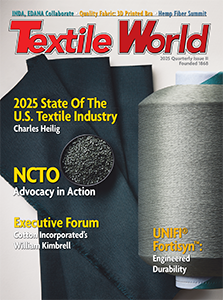Deputy United States Trade Representative (USTR) Demetrios Marantis — who is responsible for U.S.
trade negotiations and enforcement in Asia and Africa; and USTR global initiatives on trade and
development, labor and the environment — was in Los Angeles last week to meet with apparel and
textile manufacturers and other local businesses involved in international trade. The meetings
focused on how U.S. trade initiatives and customs enforcement can help boost exports and realize
President Barack Obama’s goal of doubling U.S. exports by 2015.
Marantis visited three factories including women’s apparel brand Karen Kane, which houses
its design, screen printing, research, pattern making, cutting, shipping, production and customer
service departments in its 130,000-square-foot headquarters in Vernon, Calif.; denim apparel
manufacturer New Fashion Products Inc., which produces up to 56,000 units per week in vertically
integrated facilities in Los Angeles and Mexico; and Blue River Denim Inc., an independent denim
finisher that works with many popular jeans companies and uses special processing such as laser
etching and ozone water-free laundering. Following the factory tours, Marantis participated in a
roundtable discussion with Los Angeles-based textile and apparel companies to learn of challenges
those companies face in dealing with various U.S. trading partners.
Following the meetings, Marantis spoke with Textile World about the Korea-United States Free
Trade Agreement (KORUS), which was enacted last month, and the Trans-Pacific Partnership (TPP), for
which a 12th round of negotiations will take place in Dallas in May.
With regard to U.S.-South Korea trade, Marantis said that between 2005 and 2011, U.S.
textile and apparel exports to South Korea grew by 73 percent from $241 million to $418 million,
and U.S. imports of South Korean textiles and apparel declined by 51 percent from $1.9 billion to
$928 million. Areas of high U.S. export growth include tailored men’s and women’s apparel, knit
shirts, sweaters, dresses, filament yarn and nonwoven fabrics. Marantis also noted that under
KORUS, 70 percent of Korea’s tariffs on U.S. textile and apparel imports have now been removed,
with the rest to phase out over the next five to 10 years. “Our exports to Korea were already
growing, and I think KORUS will help level the playing field and give U.S. products a competitive
edge over products from other countries. I’m hopeful that our exports of textiles and apparel to
Korea will grow significantly as a result of the agreement,” he added, repeating government
statistics that Korea represents a $1 trillion economy and that U.S. exports to Korea are expected
to grow by $10 billion to $11 billion per year and support 70,000 U.S. jobs overall.
Marantis also spoke about the TPP and the expectations and concerns of importers and U.S.
textile and apparel manufacturers. “There are both opportunities and challenges,” he acknowledged.
“For importers, it provides new sourcing opportunities in [TPP partner] Vietnam, and for
manufacturers, it provides a new platform for exporting. There are sensitivities with Vietnam,
given that it is a potential export powerhouse and what that means for U.S. manufacturers. We’re
trying to achieve a balance that will allow us to recognize the sensitivities in this sector and
also ensure that new opportunities for both sourcing and exports are realized. One way we’re trying
to do that is to ensure that we use the yarn-forward rule of origin in this agreement.” He added
that with the yarn-forward rule in place, tariff benefits will extend only to TPP parties and not
to third parties, and the agreement will create trade and sourcing patterns integrated from fiber
to end product all within the TPP region. “I am hopeful that as TPP is concluded, we will have this
balance that will include something importers can rely on vis-à-vis new sourcing opportunities,
have tools in place to address the sensitivities our sector has and create regional trade flows in
a way that helps to boost U.S. textile and apparel exports,” he said.
April 10, 2012




